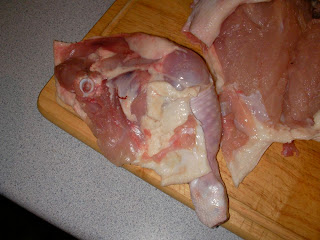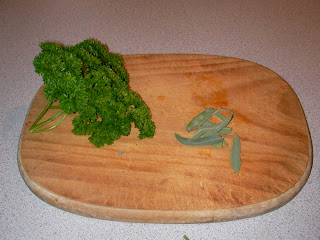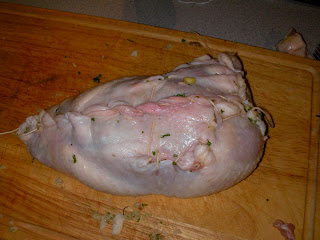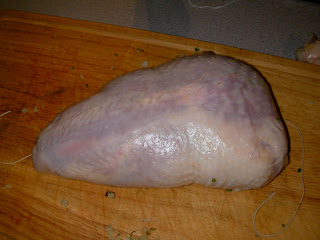Whole chickens were on special.
I removed the ribcage …
… by cutting the skin down the spine …
… and gently cutting flesh away from ribs, and severing hip and shoulder joints …
… leaving ribcage …
… and the rest of the chook:
I cut off the legs (and wings) …
… leaving the breast and most of the skin:
I peeled the skin away, …
… then rearranged the breasts on the skin in a less biologically accurate, but more even, fashion:
I made stuffing by sweating chopped onion in lots of butter …
… until it was beginning to brown …
… picked some parsley and sage from the garden …
… and chopped it up finely …
… then added the onions, butter, chopped herbs, and salt, to a cup or so of white breadcrumbs from the freezer:
The stuffing went on top of the chicken breasts …
… and I got out Uncle Ted's old upholstery needle (Uncle Ted was the husband of Auntie Helen of the steamed pudding bowl) and threaded it with string:
Bit by bit I sewed up the chicken's skin around its breast and the stuffing …
… until it was a nice neat parcel …
… which I put in an oven dish, sitting on the ribcage and wings, with the legs to the sides:
I cooked them for about 45 minutes …
… one leg was dinner, and the stuffed breast and other leg went into the fridge to be eaten cold.
The carcase and wings …
… went into a pot of water with onion and some sliced shiitake mushrooms and were boiled for a couple of hours, making a delicious stock …
… from which I removed the bones and strained the meat and mushrooms. I added the meat and mushrooms to cooked soba noodles and put stock and noodles in the fridge, ready to be reheated in portions and eaten together:
The soup and noodles were three lunches worth.

























Indigenous use of the whole chicken. You never cease to amaze me with your cooking talent. I bow to you once again.
ReplyDelete